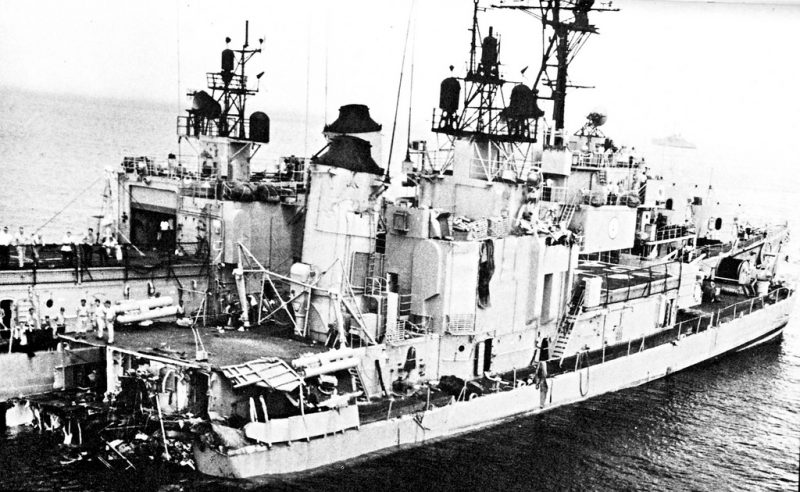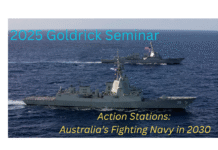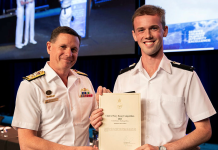
Obituary: Captain John Philip Stevenson AM RAN Ret’d
24 August 1921 – 29 January 2019
(Captain John Stevenson was captain of HMAS Melbourne at the time of the collision with the USS Frank E Evans in May 1969 in the South China Sea.)
By the staff of the Historical Section of the Sea Power Centre – Australia
John Philip Stevensonwas born in Melbourne on 24 August 1921 and entered the RAN College (HMAS Cerberus) as a 13 year old cadet midshipman in 1934. He gained his sporting colours for tennis and at passing out was awarded the prize for mathematics-physics-chemistry.
As a midshipman he served in the heavy cruiser HMAS Canberra (I) before traveling to the United Kingdom in mid-1939 for loan service with the Royal Navy. He joined the heavy cruiser, HMS Shropshire and wasserving in her in the Mediterranean when World War II broke out. Shropshire then operated in the South Atlantic and Indian Ocean on patrol and escort duties. After completing training courses in the United Kingdom he served as a sub-lieutenant in the commissioning crew of the destroyer HMAS Nestor which operated in the North Atlantic on escort, patrol and screening duties. Nestorwas involved in the hunt for the German battleship Bismarck in May 1941.
Nestor later served in the Mediterranean and South Atlantic, and on 15 December 1941 sank the German submarine U-127 off Cape St Vincent. The destroyer operated in the Indian Ocean during January – June 1942 before returning to the Mediterranean theatre. On 15 June while escorting a convoy to Malta, Nestor was badly damaged by enemy air attack and later scuttled as she could not be saved. Lieutenant Stevenson was amongst the ship’s injured. He then served in the destroyer HMAS Napier, in the Indian Ocean, before joining the now HMAS Shropshire in mid-1943 (replacing Canberrasunk at Savo Island in August 1942). Shropshireserved in the Pacific campaign during 1943-1945 and, apart from radar training in the United Kingdom, Stevenson served in her for the remainder of the war and was present at the Japanese surrender in Tokyo Bay on 2 September 1945.
After the war Lieutenant Stevenson went to the United Kingdom on loan to the Royal Navy where he underwent courses in navigation and fighter direction. He served in Royal Navy ships in the Indian Ocean, Persian Gulf, Atlantic Ocean and Mediterranean and also saw operational service in the early days of the Malayan Emergency. Promoted to lieutenant commander in 1950 he returned to Australia in the aircraft carrier HMAS Sydney (III) which had embarked her second carrier air group in Portsmouth. Upon arrival in Australia he took command, in March 1951, of the frigate HMAS Barcoo which operated as the RAN training ship. He later served in the heavy cruiser HMAS Australia (II) as navigation officer, and later re-joined Sydney as the Fleet Navigation Officer.
Sydneyvisited the United Kingdom for the coronation of Her Majesty Queen Elizabeth II where Stevenson commanded the RAN detachment during the coronation parade. In 1954 Sydney conducted a post-armistice patrol in Korean waters and in June 1954 Stevenson was promoted to commander. In 1954 Commander Stevenson was Director of Plans in Navy Office and also served in HMY Britanniaas the naval equerry to His Royal Highness the Duke of Edinburgh who was to visit Australia for the 1956 Olympic Games in Melbourne.
He commanded the destroyer HMAS Anzac (II) during January 1957 – June 1958 during which time she served in the Far East Strategic Reserve. In 1958-1959 he attended the Naval Command Course at the US Naval War College followed by the US Naval Tactical Course. In May 1959 he was appointed as the Defence attaché to Thailand and was promoted to captain in December 1960. Captain Stevenson assumed command of HMAS Watson, in October 1961, and the following October took command of the destroyer HMAS Vendetta (II) as well as commanding the 10th Destroyer Squadron.
In April 1964 he temporarily commanded the fast troop transport HMAS Sydney (III) which took Australian troops to Borneo. In 1965 he commanded HMAS Cerberus and was also Naval Officer in Command – Victoria. Then in late 1966 he became the Australian naval attaché in Washington, D.C. After returning to Australia he assumed command of the aircraft carrier HMAS Melbourne (II), then in refit, in October 1968.

Melbourne commenced work-ups in February 1969 and sailed for Southeast Asia waters on 5 May 1969 with 805, 816 and 817 Squadrons embarked. In the early hours of 3 June 1969 during Exercise SEA SPIRIT, in the South China Sea, the American destroyer USS Frank E Evans crossed Melbourne’s bow and was cut in two in an incident reminiscent of the Voyager (II) collision five years earlier. The forward section of Evans sank immediately with the loss of 74 lives and Melbourne sustained extensive damage to her bow.
A joint USN/RAN Board of Inquiry held Stevenson partly responsible stating that, as commanding officer of Melbourne, he could have done more to prevent the collision from occurring; however, a subsequent RAN court-martial cleared him of any responsibility. The integrity of the initial Board of Inquiry has since been questioned, particularly as it was presided over by Rear Admiral Jerome King, USN, the officer in overall tactical command of Evans at the time of the collision. Stevenson’s defence counsel at his court martial, Gordon Samuels, QC, stated he had “never seen a prosecution case so bereft of any possible proof of guilt.” Captain Stevenson subsequently resigned from the RAN bringing to an end a distinguished 35-year naval career.
John Stevenson worked for the Australian Gas Light Company (AGL) from 1970-1987. He retired in 1987 moving to Burradoo, NSW with his wife, Joanne in 2000. They had been married for 54 years when she died in 2012. In December 2012, Stevenson received an official apology from the Minister for Defence, the Honourable Stephen Smith, MP, in which he stated that Stevenson was not treated fairly by the government of the day and the Australian Navy following the events of 1969, and described Stevenson as ‘a distinguished naval officer who served his country with honour in peace and war’.
John Stevenson was appointed as a Member of the Order of Australia (AM) in the 2018 Australia Day Honours List. Captain John Stevenson passed away in Sydney on 29 January 2019.



